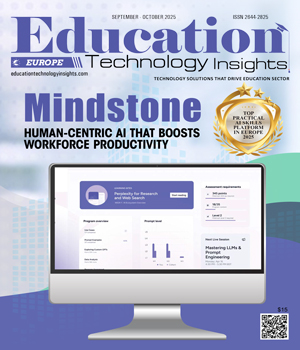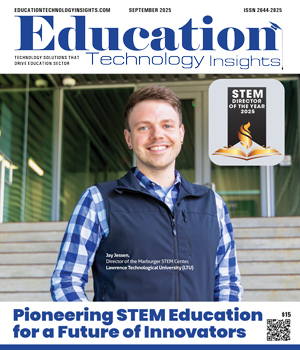THANK YOU FOR SUBSCRIBING
Be first to read the latest tech news, Industry Leader's Insights, and CIO interviews of medium and large enterprises exclusively from Education Technology Insights
Empowering Innovation through Intervention: A Vision for Inclusive, Tech-Driven Education at Darlington County School District
Carla Jefferson, Director of Intervention and Innovative Programs, Darlington County School District
From Intervention to Innovation Carla Jefferson, Director of Intervention and Innovative Programs, Darlington County School District
Carla Jefferson, Director of Intervention and Innovative Programs, Darlington County School District
My experience in intervention has given me a deep appreciation for the power of personalized support especially for students who often feel left behind in traditional learning environments. It’s taught me that every learner deserves access to the tools and strategies that work best for them. At Darlington County School District, I approach technology not as a one-size-fits-all solution but as a flexible system that should bend toward equity. We’re focused on building studentcentered ecosystems where data informs instruction, accessibility is prioritized and every scholar regardless of background, behavior or bandwidth, feels seen and supported.
In Darlington County, we’re not just chasing innovation for the sake of being cutting-edge. Our mission is rooted in transformation with a focus on restoring hope, building systems of support and opening up new futures for our students. Our alternative and virtual programs are proof points: spaces where structure and innovation coexist, where flexibility meets accountability, and where technology becomes a bridge and not a barrier to success. Leading this work is an honor and I’m committed to continuing the push for inclusive, equity-driven digital learning environments where every student has the opportunity to thrive.
One of the biggest challenges is managing the wide variability in digital readiness among both students and educators. While some thrive with new tools, others require more time, training and scaffolding. Another challenge is ensuring that tech tools are not just layered on top of instruction but meaningfully embedded into teaching and learning. To tackle this, we focus on three core strategies:
1. Intentional Professional Learning: We invest in coaching and modeling, not just a one and done training.
2.Cross-Functional Collaboration: We build bridges between instructional and technology departments so decisions are rooted in both pedagogy and practicality.
3.Feedback Loops: We center educator and student voice in our rollout process. From pilot groups to surveys to focus groups, ongoing dialogue helps us refine and adjust in real time.
Equity, Innovation and the Future of Digital Learning
AI-powered tools, immersive learning through AR/VR and predictive analytics are three of the most promising areas right now. AI offers new pathways for personalized instruction, real-time feedback and instructional planning support. AR/VR expands access to experiences that might otherwise be out of reach for rural or under-resourced schools like virtual labs, historical simulations or even career exploration. Predictive analytics can help us identify students who may be at risk academically, socially or behaviorally before they fall through the cracks.
But impact evaluation is key. In Darlington, we ask:
● Is it equitable and accessible?
● Does it enhance, not replace good instruction?
● Can it be sustained beyond the initial excitement or funding cycle?
We pair qualitative feedback with student performance data to make informed decisions about scalability
Future-proofing means designing with flexibility and longevity in mind. That includes making strategic investments in cloud-based platforms, scalable device programs and robust cyber security systems. But it also requires staying deeply connected to what's happening on the ground in our classrooms. We operate from a dual lens: innovation at the systems level, and responsiveness at the human level. Regular check-ins, classroom walkthroughs and district wide listening sessions help us stay agile and adjust course when needed. We also ensure that instructional technology decisions are never made in isolation, they are tied to our academic goals and student achievement metrics.
Start with people, not products. The most transformative initiatives are those that build trust, capacity and collective ownership. Here are five lessons I’d share:
1. Define the Why: Ground all tech initiatives in your district’s mission and student needs.
2. Invest in Professional Learning: Don’t just train but build confidence and curiosity among educators.
3. Center Equity: Design for your most vulnerable students first.
4. Pilot and Iterate: Small-scale pilots create safe spaces to experiment, fail, and grow.
5. Celebrate Early Wins: Lift up stories of impact to build momentum and community buy-in.
Read Also
From At-Risk to At-Promise: The Language Revolution Higher Education Needs
Teaching Tomorrow: How Western Governors University Is Redefining Teacher Preparation
Shaping Future Engineers Through Innovation and Hands-On Learning
From Isolation to Interaction: Reimagining Technology for Human Connection
Building an Understanding of AI in Learning Environments
Integrating SEL, Digital Citizenship, and AI Literacy in K–8 Schools

I agree We use cookies on this website to enhance your user experience. By clicking any link on this page you are giving your consent for us to set cookies. More info

However, if you would like to share the information in this article, you may use the link below:
www.educationtechnologyinsightseurope.com/cxoinsights/carla-jefferson-nid-3422.html





















